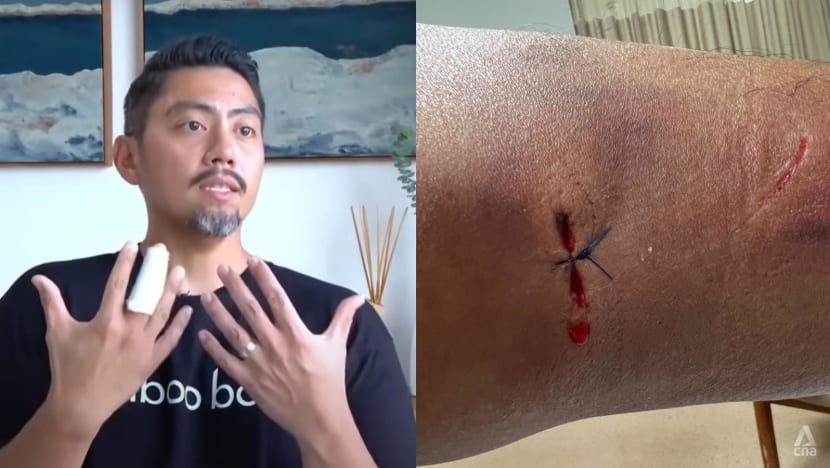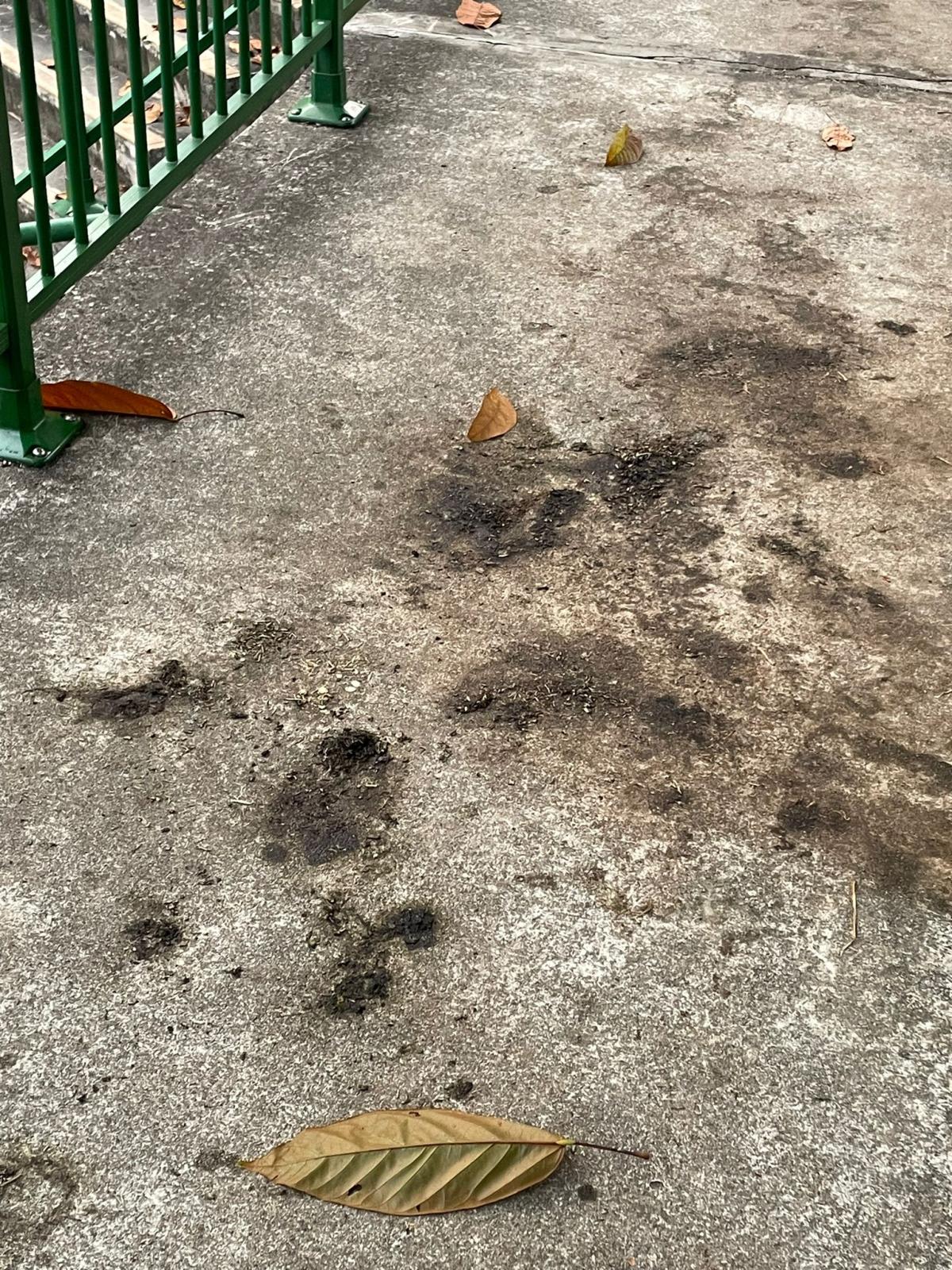‘I couldn’t feel my finger’: Sentosa Cove resident needed 3-hour surgery after otter attack
Animal experts said that while otters rarely attack unless threatened, families with young pups tend to be more protective of their babies.

Wounds suffered by Mr David Andrada after he was attacked by otters close to Tanjong Beach on Jul 11, 2024.

This audio is generated by an AI tool.
SINGAPORE: When Mr David Andrada finished his usual jogging session at Tanjong Beach and was heading home three weeks ago, he spotted several otters in an “unusual” area – next to the pedestrian walkway.
“I stopped about 4m away and I was waiting for them to basically run, go wherever else. I wasn’t going to go near because I know the dangers of wildlife,” recounted the restaurateur and Sentosa Cove resident.
What happened next stunned him.
“One of them just turned at me and literally just made a beeline straight towards me, and then the two others followed,” the Australian told CNA.
As Mr Andrada stepped backwards to run away, he fell into some bushes. That was when the otters started biting him.
“One of them, the one leading the charge, actually came up close to my face … and as self-defence, I tried to push it away but it bit my finger along the way. But I managed to push them out,” he said.
The otters then went back to the nearby waters. Mr Andrada sought help from a nearby gardener before eventually getting treatment at Singapore General Hospital.
“I was bloodied everywhere. I couldn’t feel my finger anymore at that time so I was a bit worried,” he said.
The incident left him with gaping wounds on his thigh, calf and finger. He needed a three-hour surgery mainly due to his finger, receiving 10 stitches and a tetanus shot.
He ended up being warded for five days and was left with a hefty hospital bill amounting to tens of thousands of dollars, despite having medical insurance.
Doctors said his finger could take up to six months to recover.
RARE FOR OTTERS TO ATTACK
While Mr Andrada said he still does not know why the otters turned violent, animal experts said that those with young pups – typically one to two months old – tend to be more protective of their babies.
It is rare for otters to attack unless they feel threatened, they added.
Other residents said they have seen a family with young pups in the area where Mr Andrada was attacked.
National University of Singapore biological scientist N Sivasothi, also known as “Otterman”, said otters that are typically seen in the open are “quite used to people” and will leave humans alone. The only time this changes is when a family is raising their pups.
“The adults are a bit more cautious with people who are coming too close,” he added.
The National Parks Board (NParks), which oversees animal-related matters in Singapore, said members of the public should keep a safe distance when they come across otters.
People should avoid feeding, touching, chasing, cornering, or approaching them. This is especially when there are pups, as the adults can be protective over their young when approached by humans, added NParks.

So far, there have been at least three other reports of otters injuring humans over the past three years.
Notably, in 2021, Singapore permanent resident Graham George Spencer was bit in the legs, buttock and finger by about 20 otters at the Singapore Botanic Gardens. He was left with more than 20 wounds, with some requiring stitches.
The furry critters are better known for invading homes and ponds to eat fish that can cost thousands of dollars.
A group of them in Seletar made headlines in 2022 when they entered a private home and killed more than 50 fish in a pond. Following this, a family of six smooth-coated otters were relocated to an undisclosed area where they could access their natural food sources.
MORE SPOTTING OTTERS IN PUBLIC
According to figures by NParks, more residents have been giving feedback on otters in recent years.
There were 208 reports on otters in 2020, and 305 in 2021. The statutory board then received 440 reports on average from 2022 to 2023, with a majority of the feedback being about otter sightings.
Dr Sivasothi said that while people are much more informed about how to deal with wildlife now, there remains a need for greater education and awareness.
While more are spotting otters out and about, he added that he believes the population in Singapore is beginning to stagnate.
The full picture will only be known next year when experts, including Dr Sivasothi, complete a survey of Singapore’s otter population.
There were almost 80 otters in 2017, doubling to about 170 in 2021 due to families having multiple litters. The biggest family of otters ever recorded had around 20 members.
There is no double-counting because the team recognises otters by distinct characteristics on their fur or bodies.
“In the past few years, these large groups seem to have … become much smaller,” noted Dr Sivasothi.
“It could be the resources in the waterway. All these fish populations (are) now not as high as they used to be. There's also competition for space, so all of these will naturally limit the number of otters.
“When we’re doing our third census this year, we don’t expect to find animal increases, but there might be many more smaller groups,” he added.
EMOTIONAL SCARS
For Mr Andrada, the otter attack left him so traumatised that he has not returned to the area, where residents use a gate to get from their homes to the beach.
“Until someone tells me that it’s safe, I’m not going to let my children go there because you know the size of these otters … they're quite heavy and they're quite strong as well,” said the father of three.
Mr Andrada also informed the National Parks Board and Sentosa Development Corporation about the incident, adding that he had “good conversations” with them.
His condominium management has since put up signs warning people what not to do if they encounter otters. This includes no touching, no chasing, no flash photography, and not getting too close to the critters.
As for his injuries, Mr Andrada said he still cannot feel one part of his finger.
“I said to (the authorities), if it was a child, it could have been fatal because they were close to my face,” he added.
“And if I didn't manage to paw them off, it could have been a different story – probably some bite marks on my face.”


















